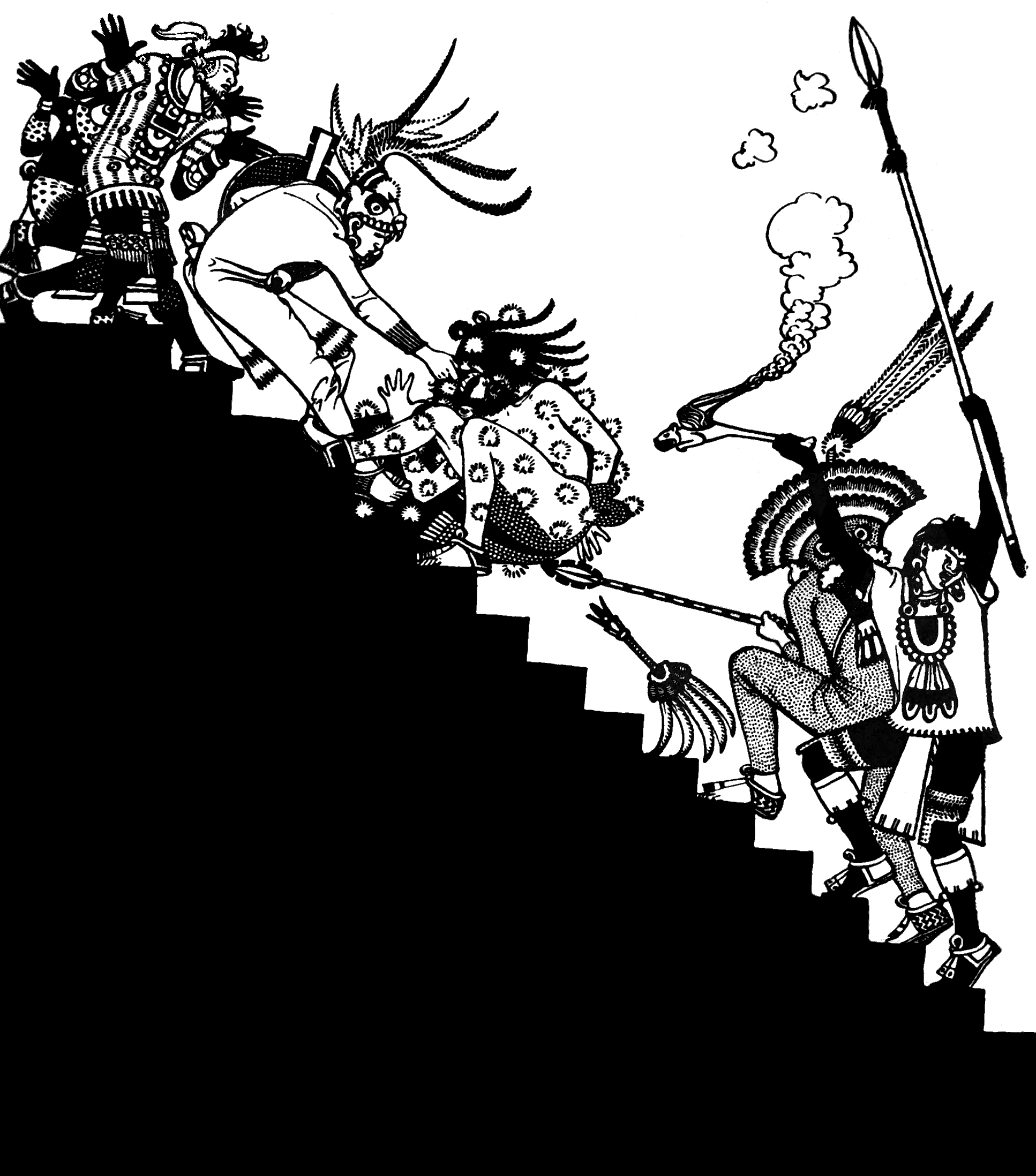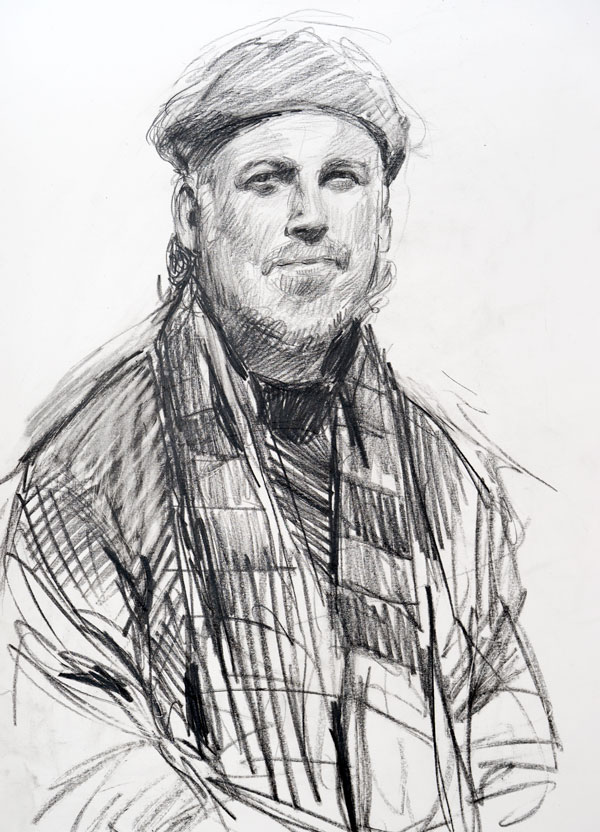|
Chacmool
A chacmool (also spelled chac-mool) is a form of pre-Columbian Mesoamerican sculpture depicting a reclining figure with its head facing 90 degrees from the front, supporting itself on its elbows and supporting a bowl or a disk upon its stomach. These figures possibly symbolised slain warriors carrying offerings to the gods; the bowl upon the chest was used to hold sacrificial offerings, including pulque, tamales, tortillas, tobacco, turkeys, feathers and incense. In an Aztec example, the receptacle is a cuauhxicalli (a stone bowl to receive sacrificed human hearts). Chacmools were often associated with sacrificial stones or thrones.Miller and Taube 1993, 2003, p. 60. Aztec chacmools bore water imagery and were associated with Tlaloc, the rain god. Their symbolism placed them on the frontier between the physical and supernatural realms, as intermediaries with the gods. The chacmool form of sculpture first appeared around the 9th century AD in the Valley of Mexico and the northern ... [...More Info...] [...Related Items...] OR: [Wikipedia] [Google] [Baidu] |
Human Sacrifice In Aztec Culture
Human sacrifice was common in many parts of Mesoamerica, so the rite was nothing new to the Aztecs when they arrived at the Valley of Mexico, nor was it something unique to pre-Columbian Mexico. Other Mesoamerican cultures, such as the Purépechas and Toltecs, and the Maya performed sacrifices as well and from archaeological evidence, it probably existed since the time of the Olmecs (1200–400 BC), and perhaps even throughout the early farming cultures of the region. However, the extent of human sacrifice is unknown among several Mesoamerican civilizations. What distinguished Aztec practice from Maya human sacrifice was the way in which it was embedded in everyday life. These cultures also notably sacrificed elements of their own population to the gods. In 1519, explorers such as Hernán Cortés conquered the Aztec capital of Tenochtitlan and made observations of and wrote reports about the practice of human sacrifice. Bernal Díaz del Castillo, who participated in the ... [...More Info...] [...Related Items...] OR: [Wikipedia] [Google] [Baidu] |
Augustus Le Plongeon
Augustus Henry Julian Le Plongeon (4 May 1825 – 13 December 1908) was a British-American archeologist and photographer who studied the pre-Columbian ruins of America, particularly those of the Maya civilization on the northern Yucatán Peninsula. While his writings contain many notions that were not well received by his contemporaries and were later disproven, Le Plongeon left a lasting legacy in his photographs documenting the ancient ruins. He was one of the earliest proponents of Mayanism. Early life and careers Le Plongeon was born on the island of Jersey on 4 May 1825.Desmond (2011) At 19, he sailed to South America and shipwrecked off the coast of Chile. While there he settled in Valparaiso and taught mathematics, drawing, and languages at a local college. In 1849 he sailed to San Francisco during the California gold rush to work as a surveyor, and also apprenticed to become a doctor of medicine. One of his accomplishments as a surveyor included drawing a plan for t ... [...More Info...] [...Related Items...] OR: [Wikipedia] [Google] [Baidu] |
Metamorphic Rock
Metamorphic rocks arise from the transformation of existing rock to new types of rock in a process called metamorphism. The original rock (protolith) is subjected to temperatures greater than and, often, elevated pressure of or more, causing profound physical or chemical changes. During this process, the rock remains mostly in the solid state, but gradually recrystallizes to a new texture or mineral composition. The protolith may be an igneous, sedimentary, or existing metamorphic rock. Metamorphic rocks make up a large part of the Earth's crust and form 12% of the Earth's land surface. They are classified by their protolith, their chemical and mineral makeup, and their texture. They may be formed simply by being deeply buried beneath the Earth's surface, where they are subject to high temperatures and the great pressure of the rock layers above. They can also form from tectonic processes such as continental collisions, which cause horizontal pressure, friction, and distorti ... [...More Info...] [...Related Items...] OR: [Wikipedia] [Google] [Baidu] |
Purépecha Language
Purépecha (also ''P'urhépecha'' , tsz, Phorhé or ''Phorhépecha''), often called Tarascan, which is a pejorative term coined by Spanish colonizers ( es, Tarasco), is a language isolate or small language family that is spoken by some 140,000 Purépecha in the highlands of Michoacán, Mexico. Purépecha was the main language of the pre-Columbian Tarascan State and became widespread in the region during its heyday in the late post-Classic period. The small town of Purepero got its name from the indigenous people who lived there. Even though it is spoken within the boundaries of Mesoamerica, Purépecha does not share many of the traits defining the Mesoamerican language area, suggesting that the language is a remnant of an indigenous pre-Aztec substrate that existed several thousands of years ago before the migration of speakers that contributed to the formation of the sprachbund, or alternatively is a relatively new arrival to the area. Classification Purépecha has long bee ... [...More Info...] [...Related Items...] OR: [Wikipedia] [Google] [Baidu] |
Toltec
The Toltec culture () was a Pre-Columbian era, pre-Columbian Mesoamerican culture that ruled a state centered in Tula (Mesoamerican site), Tula, Hidalgo (state), Hidalgo, Mexico, during the Epiclassic and the early Post-Classic period of Mesoamerican chronology, reaching prominence from 950 to 1150 CE. The later Aztec culture saw the Toltecs as their intellectual and cultural predecessors and described Toltec culture emanating from Tollan, ''Tōllān'' (Nahuatl language, Nahuatl for Tula) as the epitome of civilization; in the Nahuatl language the word ''Tōltēkatl'' (singular) or ''Tōltēkah'' (plural) came to take on the meaning "artisan". The Aztec oral tradition, oral and pictographic tradition also described the history of a Toltec Empire, giving lists of rulers and their exploits. Modern scholars debate whether the Aztec narratives of Toltec history should be given credence as descriptions of actual historical events. While all scholars acknowledge that there is a lar ... [...More Info...] [...Related Items...] OR: [Wikipedia] [Google] [Baidu] |
National Museum Of Anthropology
The National Museum of Anthropology ( es, Museo Nacional de Antropología, MNA) is a national museum of Mexico. It is the largest and most visited museum in Mexico. Located in the area between Paseo de la Reforma and Mahatma Gandhi Street within Chapultepec Park in Mexico City, the museum contains significant archaeological and anthropological artifacts from Mexico's pre-Columbian heritage, such as the Stone of the Sun (or the Aztec calendar stone) and the Aztec Xochipilli statue. The museum (along with many other Mexican national and regional museums) is managed by the Instituto Nacional de Antropología e Historia (National Institute of Anthropology and History), or INAH. It was one of several museums opened by Mexican President Adolfo López Mateos in 1964. Assessments of the museum vary, with one considering it "a national treasure and a symbol of identity. The museum is the synthesis of an ideological, scientific, and political feat." Octavio Paz criticized the museum' ... [...More Info...] [...Related Items...] OR: [Wikipedia] [Google] [Baidu] |
Centennial Exposition
The Centennial International Exhibition of 1876, the first official World's Fair to be held in the United States, was held in Philadelphia, Pennsylvania, from May 10 to November 10, 1876, to celebrate the 100th anniversary of the signing of the Declaration of Independence in Philadelphia. Officially named the International Exhibition of Arts, Manufactures, and Products of the Soil and Mine, it was held in Fairmount Park along the Schuylkill River on fairgrounds designed by Herman J. Schwarzmann. Nearly 10 million visitors attended the exposition, and 37 countries participated in it. Precursor The Great Central Fair on Logan Square in Philadelphia, Pennsylvania, in 1864 (also known as the Great Sanitary Fair), was one of the many United States Sanitary Commission's Sanitary Fairs held during the Civil War. They provided a creative and communal means for ordinary citizens to promote the welfare of Union soldiers and dedicate themselves to the survival of the nation, and the ... [...More Info...] [...Related Items...] OR: [Wikipedia] [Google] [Baidu] |
Worcester, Massachusetts
Worcester ( , ) is a city and county seat of Worcester County, Massachusetts, United States. Named after Worcester, England, the city's population was 206,518 at the 2020 United States census, 2020 census, making it the second-List of cities in New England by population, most populous city in New England after Boston. Worcester is approximately west of Boston, east of Springfield, Massachusetts, Springfield and north-northwest of Providence, Rhode Island, Providence. Due to its location near the geographic center of Massachusetts, Worcester is known as the "Heart of the Commonwealth"; a heart is the official symbol of the city. Worcester developed as an industrial city in the 19th century due to the Blackstone Canal and rail transport, producing machinery, textiles and wire. Large numbers of European immigrants made up the city's growing population. However, the city's manufacturing base waned following World War II. Long-term economic and population decline was not reversed ... [...More Info...] [...Related Items...] OR: [Wikipedia] [Google] [Baidu] |
Stephen Salisbury
Stephen Salisbury III (1835–1905), also referred to as Stephen Salisbury Jr., was an American businessman, lawyer, and politician. The son of a wealthy landowner, Salisbury helped manage the family's extensive properties and businesses in Worcester County, Massachusetts. Like his father, Salisbury served in the State Senate, was president of the Worcester National Bank, and directed the Worcester & Nashua Railroad. He was a trustee of the Worcester City Hospital and the Worcester Polytechnic Institute. Biography Stephen Salisbury III was born in Worcester on March 31, 1835. He graduated from Harvard College in 1856, and studied abroad for two years at Friedrich Wilhelm University. He received a degree from Harvard Law School in 1861, and was admitted to the bar that October. Like his father, he maintained a long association with the American Antiquarian Society. He was elected a member in 1863, served on its board of councilors from 1847 to 1884, as vice-president from 188 ... [...More Info...] [...Related Items...] OR: [Wikipedia] [Google] [Baidu] |
David Carrasco
Davíd Lee Carrasco is an American academic historian of religion, anthropologist, and Mesoamericanist scholar. As of 2001 he holds the inaugural appointment as Neil L. Rudenstine Professor of Latin America Studies at the Harvard Divinity School, in a joint appointment with the Faculty of Arts and Sciences' Department of Anthropology at Harvard University. Carrasco previously taught at the University of Colorado, Boulder and Princeton University and is known for his research and publications on Mesoamerican religion and history, his public speaking as well as wider contributions within Latin American studies and Latino/a studies. He has made statements about Latino contributions to US democracy in public dialogues with Cornel West, Toni Morrison, and Samuel P. Huntington. His work is known primarily for his writings on the ways human societies orient themselves with sacred places. Early life and education Carrasco descends from several generations of El Paso, Texas educators. ... [...More Info...] [...Related Items...] OR: [Wikipedia] [Google] [Baidu] |








